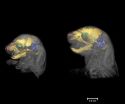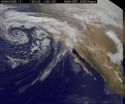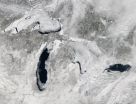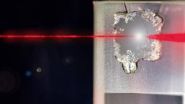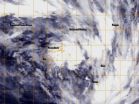(Press-News.org) Three dimensional imaging of two different mouse models of Apert Syndrome shows that cranial deformation begins before birth and continues, worsening with time, according to a team of researchers who studied mice to better understand and treat the disorder in humans.
Apert Syndrome is caused by mutations in FGFR2 -- fibroblast growth factor receptor 2 -- a gene, which usually produces a protein that functions in cell division, regulation of cell growth and maturation, formation of blood vessels, wound healing, and embryonic development. With certain mutations, this gene causes the bones in the skull to fuse together early, beginning in the fetus. These mutations also cause mid-facial deformation, a variety of neural, limb and tissue malformations and may lead to cognitive impairment.
Understanding the growth pattern of the head in an individual, the ability to anticipate where the bones will fuse and grow next, and using simulations "could contribute to improved patient-centered outcomes either through changes in surgical approach, or through more realistic modeling and expectation of surgical outcome," the researchers said in today's (Feb. 28) issue of BMC Developmental Biology.
Joan T. Richtsmeier, Distinguished Professor of Anthropology, Penn State, and her team looked at two sets of mice, each having a different mutation that causes Apert Syndrome in humans and causes similar cranial problems in the mice. They checked bone formation and the fusing of sutures, soft tissue that usually exists between bones n the skull, in the mice at 17.5 days after conception and at birth -- 19 to 21 days after conception.
"It would be difficult, actually impossible, to observe and score the exact processes and timing of abnormal suture closure in humans as the disease is usually diagnosed after suture closure has occurred," said Richtsmeier. "With these mice, we can do this at the anatomical level by visualizing the sutures prenatally using micro-computed tomography -- 3-D X-rays -- or at the mechanistic level by using immunohistochemistry, or other approaches to see what the cells are doing as the sutures close."
The researchers found that both sets of mice differed in cranial formation from their littermates that were not carrying the mutation and that they differed from each other. They also found that the changes in suture closure in the head progressed from 17.5 days to birth, so that the heads of newborn mice looked very different at birth than they did when first imaged prenatally.
Apert syndrome also causes early closure of the sutures between bones in the face. Early fusion of bones of the skull and of the face makes it impossible for the head to grow in the typical fashion. The researchers found that the changed growth pattern contributes significantly to continuing skull deformation and facial deformation that is initiated prenatally and increases over time.
"Currently, the only option for people with Apert syndrome is rather significant reconstructive surgery, sometimes successive planned surgeries that occur throughout infancy and childhood and into adulthood," said Richtsmeier. "These surgeries are necessary to restore function to some cranial structures and to provide a more typical morphology for some of the cranial features."
Using 3-D imaging, the researchers were able to estimate how the changes in the growth patterns caused by either of the two different mutations produced the head and facial deformities.
"If what we found in mice is analogous to the processes at work in humans with Apert syndrome, then we need to decide whether or not a surgical approach that we know is necessary is also sufficient," said Richtsmeier. "If it is not in at least some cases, then we need to be working towards therapies that can replace or further improve surgical outcomes."
INFORMATION:
Other Penn State researchers on this project include Susan M. Motch Perrine, post doctoral research assistant, and Neus Martínez-Abadías, former post doctoral fellow, now at Center for Genomic Regulation, Barcelona, Spain. Other researchers include Theodore M. Cole III, associate teaching professor, University of Missouri-Kansas City School of Medicine; Kristina Aldridge, former post doctoral fellow at Penn State and currently assistant professor, University of Missouri-Columbia; and Ethylin Wang Jabs, professor, Icahn School of Medicine at Mount Sinai.
The National Institute of Dental and Craniofacial Research, the American Recovery and Reinvestment Act and the National Science Foundation partially funded this work.
3-D imaging sheds light on Apert syndrome development
2014-02-28
ELSE PRESS RELEASES FROM THIS DATE:
GOES-West satellite eyes soggy storm approaching California
2014-02-28
A swirling Eastern Pacific Ocean storm system headed for California was spotted by NOAA's GOES-West satellite on February 28. According to the National Weather Service, this storm system has the potential to bring heavy rainfall to the drought-stricken state.
The storm was captured using visible data from NOAA's GOES-West or GOES-15 satellite on Feb. 28 at 1430 UTC/6:30 a.m. PST was made into an image by NASA/NOAA's GOES Project at NASA's Goddard Space Flight Center in Greenbelt, Md. The storm's center appeared as a tight swirl, with bands of clouds and showers already ...
NASA satellite sees great freeze over Great Lakes
2014-02-28
At night, as cold settles in, lake ice creaks and groans. It's been excessively cold, and I camped exposed on the snow-swept surface. Other than the lack of vegetation and the sounds at night, you'd never know you were on a lake. It feels like an empty plain. In some places, you see pressure ridges where ice has pushed into itself, sticking up like clear blue stegosaurus plates. -- Craig Childs
Author Craig Childs is not describing an Arctic lake. He's describing the bitterly cold and frozen scene on Lake Superior, during his February 2014 trek on the ice near the coast ...
Ultra-fast laser spectroscopy lights way to understanding new materials
2014-02-28
Scientists at the U.S. Department of Energy's Ames Laboratory are revealing the mysteries of new materials using ultra-fast laser spectroscopy, similar to high-speed photography where many quick images reveal subtle movements and changes inside the materials. Seeing these dynamics is one emerging strategy to better understanding how new materials work, so that we can use them to enable new energy technologies.
Physicist Jigang Wang and his colleagues recently used ultra-fast laser spectroscopy to examine and explain the mysterious electronic properties of iron-based superconductors. ...
Detection of water vapor in the atmosphere of a hot jupiter
2014-02-28
Although liquid water covers a majority of Earth's surface, scientists are still searching for planets outside of our solar system that contain water. Researchers at Caltech and several other institutions have used a new technique to analyze the gaseous atmospheres of such extrasolar planets and have made the first detection of water in the atmosphere of the Jupiter-mass planet orbiting the nearby star tau Boötis. With further development and more sensitive instruments, this technique could help researchers learn about how many planets with water—like Earth—exist within ...
Smoke in the water: Understanding the effects of smoke compounds on seed germination
2014-02-28
Although seemingly destructive, wildfires help to maintain biodiversity and are an important element of many ecosystems throughout the world. Not only do fires discourage non-native and invasive species from becoming established, but the quick release of nutrients, heat, and compounds found in ash and smoke play an important role in the life cycle of the native flora. For plants that are adapted to ecosystems where fire is a regular occurrence—such as savannas, grasslands, and coniferous forests—exposure to fire may initiate seed germination or enhance plant growth.
Recent ...
The nature of color: New formula to calculate hue improves accuracy of color analysis
2014-02-28
A stroll through the produce aisle in your local grocery store exhibits a plethora of vivid colors. From opposing hues, like red apples next to green celery, to subtler variations, such as light to dark purple grapes, every color seems to hold its own unique attraction. Is there a way to precisely measure these hundreds of colors? This is a crucial question for scientists studying the biological importance of color in nature, but measuring color is much more challenging than measuring other characteristics, like size or weight. In recent work, University of Colorado researcher ...
Tropical Cyclone 16P forms near Fiji
2014-02-28
Tropical Cyclone 16P formed near Fiji after lingering in the region for several days as a tropical low pressure area. NOAA's GOES-West satellite captured an infrared image of the storm on February 28.
NOAA's GOES-West satellite image showed the center of Tropical Cyclone 16P to the northeast of Fiji and over Vanua Levu. Broken bands of thunderstorms wrapping from the north to the east and southeast reached Wallis and Fortuna, Samoa, Niue and Tonga.
At 0900 UTC/4 a.m. EST, Tropical Cyclone 16P was centered about 170 nautical miles/`95.6 miles/314.8 km northeast of Suva, ...
To teach scientific reproducibility, start young
2014-02-28
DURHAM, N.C. -- The ability to duplicate an experiment and its results is a central tenet of the scientific method, but recent research has shown an alarming number of peer-reviewed papers are irreproducible.
A team of math and statistics professors has proposed a way to address one root of that problem by teaching reproducibility to aspiring scientists, using software that makes the concept feel logical rather than cumbersome.
Researchers from Smith College, Duke University and Amherst College looked at how introductory statistics students responded to a curriculum ...
Asthma drug aids simultaneous desensitization to several food allergies, study finds
2014-02-28
STANFORD, Calif. — An asthma drug accelerates the process of desensitizing patients with food allergies to several foods at the same time, a new study by researchers at the Stanford University School of Medicine and Lucile Packard Children's Hospital Stanford shows.
The findings come on the heels of a recent study by the same team showing that people with multiple food allergies can be desensitized to several foods at once. The two studies, both phase-1 safety trials, provide the first scientific evidence that a promising new method for treating people for multiple food ...
Beneficial anti-inflammatory effects observed when plant extracts fed to sick pigs
2014-02-28
URBANA, Ill. – Porcine reproductive and respiratory syndrome (PRRS) is the most expensive and invasive disease for pig producers on a global scale. Though it is not occurring on every farm, it is the biggest disease problem in the pig industry, said a University of Illinois animal sciences researcher.
E. coli has also been a problem historically and continues to be on an industry-wide basis, said James Pettigrew. "Either disease can sweep through a farm so their alleviation would substantially reduce production costs. Even though many management practices have been used ...
